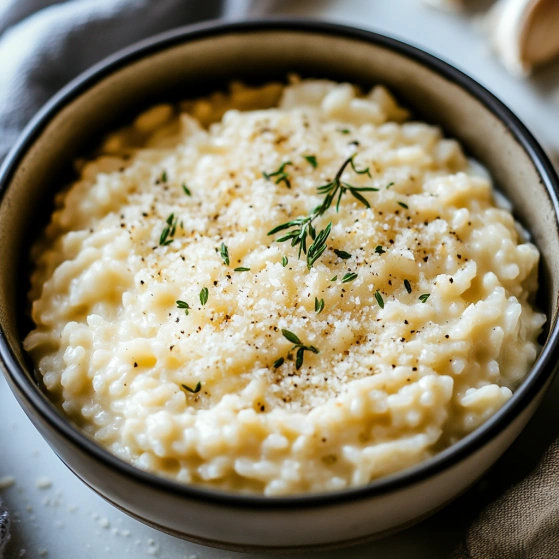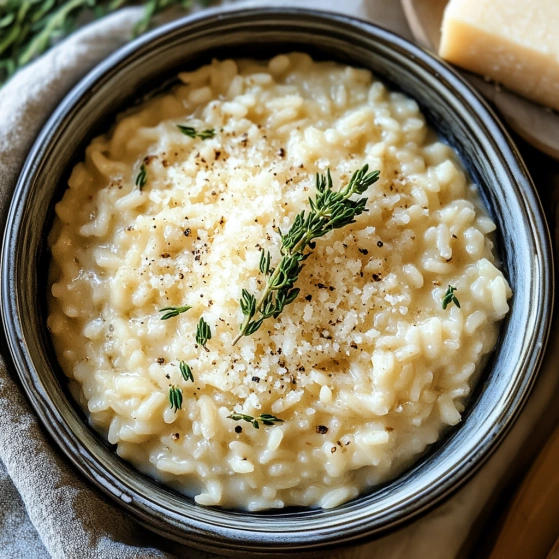 Pin it
Pin it
Arborio rice transforms into the most luxurious, creamy dish when cooked slowly with good broth and finished with Parmesan cheese. This Garlic Parmesan Risotto delivers exceptional flavor without the traditional constant stirring. The slow cooker does the hard work, allowing the rice to gradually absorb the liquid while developing that signature velvety texture that makes risotto so special. It's rich, comforting, and surprisingly simple to prepare.
I served this at my last dinner party and several guests asked for the recipe, shocked when I revealed it came from my slow cooker rather than hours of standing over the stove. My husband, normally indifferent to rice dishes, went back for seconds and claimed it was better than what we'd had at our anniversary dinner.
Essential Ingredients
- Arborio rice: The essential foundation of any risotto. Its high starch content creates that creamy texture without becoming mushy. Look for pearls that are plump, white, and uniform in size.
- Chicken or vegetable broth: Provides the flavor base that the rice absorbs. Homemade is wonderful, but a good-quality store-bought broth works beautifully too. I prefer low-sodium versions to control the salt level.
- White wine: Adds brightness and depth. Choose something dry that you'd enjoy drinking. A Pinot Grigio or Sauvignon Blanc works well. If omitting, add an extra 1/2 cup of broth.
- Onion: Creates a sweet, aromatic foundation. Select firm onions without soft spots or sprouting.
- Garlic: Infuses the rice with warm, nutty notes. Fresh cloves yield the best flavor—avoid pre-minced versions.
- Parmesan cheese: The star that brings everything together. Grate it yourself from a block for superior melting and flavor.
- Heavy cream: Adds luxurious richness at the finish. The fat content matters—don't substitute half-and-half or milk.
- Fresh parsley: Brightens the dish with color and a fresh counterpoint to the richness. Italian flat-leaf varieties offer more flavor than curly parsley.
Step-by-Step Instructions
- Step 1:
- Prepare the base: Finely chop one medium onion until the pieces are about 1/4-inch in size—this ensures they'll melt into the risotto. Mince the garlic cloves thoroughly, allowing them to rest for at least 5 minutes after chopping to activate their beneficial compounds. Measure your Arborio rice accurately—too much will absorb too much liquid, too little will create a soupy texture.
- Step 2:
- Combine ingredients: Add the measured Arborio rice to your slow cooker, followed by the chopped onion and minced garlic. Pour in the broth and white wine, then stir thoroughly to ensure no dry rice remains stuck to the bottom or sides of the pot. This initial mixing is crucial for even cooking.
- Step 3:
- Slow cook: Cover the slow cooker with its lid and set to low heat. This gentle cooking process allows the rice to gradually absorb the liquid while releasing its starches. Plan for 2-3 hours total cooking time, but begin checking at the 2-hour mark as slow cookers vary in temperature.
- Step 4:
- Intermittent stirring: Although not as demanding as stovetop risotto, you'll still want to stir every 30-45 minutes. This prevents sticking and helps distribute the liquid evenly. When stirring, scrape the bottom and sides thoroughly with a wooden spoon or silicone spatula.
- Step 5:
- Test for doneness: Around the 2-hour mark, taste a few grains of rice. They should be tender but still have a slight firmness at the center—not crunchy but not completely soft. The mixture should look creamy but not soupy. If needed, continue cooking in 15-minute increments.
- Step 6:
- Finish with cheese and cream: Once the rice reaches the proper texture, remove the slow cooker lid and stir in the freshly grated Parmesan cheese and heavy cream. The residual heat will melt the cheese and incorporate the cream without breaking the sauce. Season thoughtfully with salt and freshly ground black pepper to taste, remembering that Parmesan adds saltiness.
- Step 7:
- Rest briefly: Allow the finished risotto to rest uncovered for 5 minutes before serving. This final resting period helps the flavors meld and the texture set to perfection. Ladle into warmed bowls and garnish with chopped fresh parsley just before serving for the most vibrant color and flavor.
 Pin it
Pin it
My grandmother used to make risotto with whatever vegetables were in season, and garlic was always her secret weapon. She believed it warded off everything from colds to unwelcome relatives. While I can't verify the relative-repelling properties, I've noticed my family gets fewer winter colds when I incorporate garlic-heavy dishes like this risotto into our rotation. Even my picky eight-year-old, who normally inspects every bite for 'green things,' gladly devours this creamy rice.
The Perfect Wine Pairing
Risotto's creamy texture and subtle flavors make it an exceptional canvas for wine pairing. A crisp, unoaked Chardonnay complements the dish without overwhelming it, while a light Pinot Grigio echoes the brightness if you've used it in the cooking process. For red wine enthusiasts, choose something light-bodied like a Pinot Noir. The acidity cuts through the creaminess while the fruit notes enhance the nutty Parmesan. I've found that serving the same wine you cook with creates a harmonious dining experience, allowing guests to taste how the cooking process transforms and integrates the wine's flavors.
Make-Ahead and Storage Tips
This risotto actually improves with a bit of rest, making it ideal for entertaining. Prepare it up to an hour before serving, keeping it covered in the turned-off slow cooker. Just before guests arrive, stir in an additional splash of warm broth to refresh the texture. Leftovers store beautifully in airtight containers for up to three days, though the rice will absorb more liquid and thicken considerably. When reheating, add a tablespoon of broth or water per cup of risotto, then warm gently on the stovetop or microwave at 50% power, stirring frequently to restore its creamy consistency without breaking the delicate sauce.
 Pin it
Pin it
Seasonal Variations Worth Trying
The beauty of this basic garlic Parmesan risotto lies in its adaptability throughout the year. In spring, fold in blanched asparagus tips and fresh peas during the final cheese-adding step. Summer calls for sweet corn kernels and halved cherry tomatoes that burst with brightness against the creamy backdrop. Autumn brings opportunities for diced roasted butternut squash and crispy sage leaves fried in brown butter as a garnish. Winter versions welcome sautéed mushrooms and a drizzle of truffle oil for special occasions. These seasonal additions should be prepared separately and incorporated at the end to maintain their distinct textures and flavors, transforming this reliable recipe into something that feels brand new with each season.
Frequently Asked Questions
- → What type of rice is best for risotto?
Arborio rice is ideal for risotto because it has a high starch content, which gives the dish its creamy texture.
- → Can I use vegetable broth instead of chicken broth?
Yes, vegetable broth is a great substitute for chicken broth and works well to keep the dish vegetarian.
- → What can I use instead of white wine?
If white wine is not an option, you can replace it with an equal amount of extra broth or a splash of lemon juice for acidity.
- → How can I make my risotto creamier?
To make risotto creamier, stir in heavy cream and freshly grated Parmesan cheese towards the end of cooking.
- → Can I prepare this recipe without a slow cooker?
Yes, you can cook risotto in a pot on the stovetop by gradually adding broth and stirring until the rice absorbs the liquid and becomes creamy.
